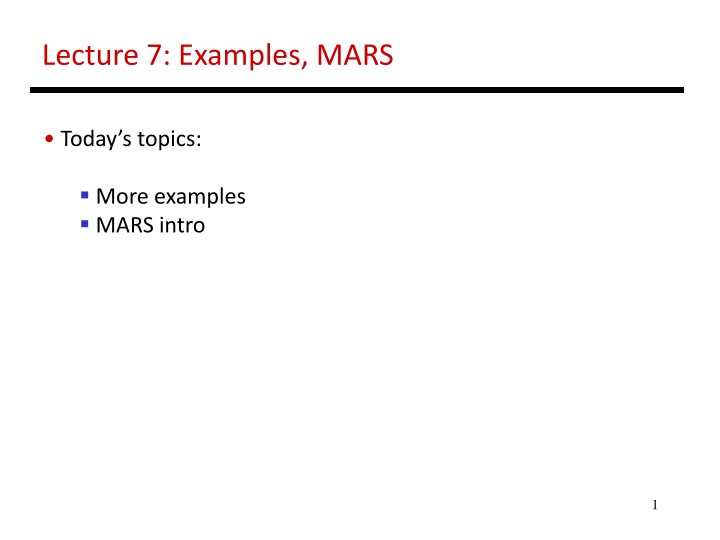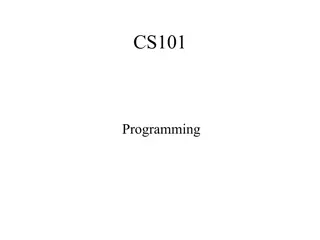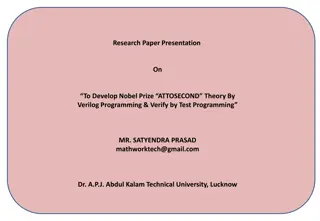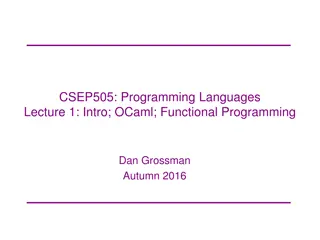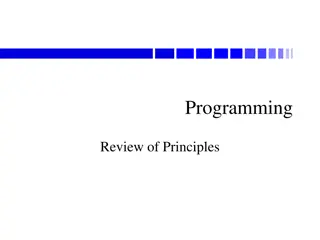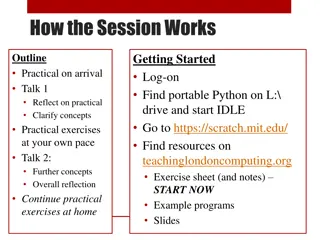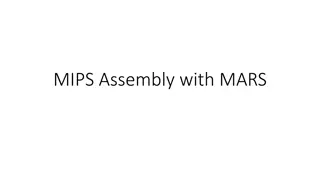Examples and Concepts in MARS Programming
Today's topics cover more examples and an introduction to MARS. Learn about dealing with characters in instructions, using ASCII formats, and converting code to assembly. Explore handling large constants, starting a program from C to machine language, and the roles of assemblers and linkers in program development.
Download Presentation

Please find below an Image/Link to download the presentation.
The content on the website is provided AS IS for your information and personal use only. It may not be sold, licensed, or shared on other websites without obtaining consent from the author.If you encounter any issues during the download, it is possible that the publisher has removed the file from their server.
You are allowed to download the files provided on this website for personal or commercial use, subject to the condition that they are used lawfully. All files are the property of their respective owners.
The content on the website is provided AS IS for your information and personal use only. It may not be sold, licensed, or shared on other websites without obtaining consent from the author.
E N D
Presentation Transcript
Lecture 7: Examples, MARS Today s topics: More examples MARS intro 1
Dealing with Characters Instructions are also provided to deal with byte-sized and half-word quantities: lb (load-byte), sb, lh, sh These data types are most useful when dealing with characters, pixel values, etc. C employs ASCII formats to represent characters each character is represented with 8 bits and a string ends in the null character (corresponding to the 8-bit number 0); A is 65, a is 97 2
Example 3 (pg. 108) strcpy: addi $sp, $sp, -4 sw $s0, 0($sp) add $s0, $zero, $zero L1: add $t1, $s0, $a1 lb $t2, 0($t1) add $t3, $s0, $a0 sb $t2, 0($t3) beq $t2, $zero, L2 addi $s0, $s0, 1 j L1 L2: lw $s0, 0($sp) addi $sp, $sp, 4 jr $ra Convert to assembly: void strcpy (char x[], char y[]) { int i; i=0; while ((x[i] = y[i]) != `\0 ) i += 1; } Notes: Temp registers not saved. 3
Large Constants Immediate instructions can only specify 16-bit constants The lui instruction is used to store a 16-bit constant into the upper 16 bits of a register combine this with an OR instruction to specify a 32-bit constant The destination PC-address in a conditional branch is specified as a 16-bit constant, relative to the current PC A jump (j) instruction can specify a 26-bit constant; if more bits are required, the jump-register (jr) instruction is used 4
Starting a Program x.c C Program Compiler x.s Assembly language program Assembler x.a, x.so x.o Object: machine language module Object: library routine (machine language) Linker Executable: machine language program a.out Loader 5 Memory
Role of Assembler Convert pseudo-instructions into actual hardware instructions pseudo-instrs make it easier to program in assembly examples: move , blt , 32-bit immediate operands, labels, etc. Convert assembly instrs into machine instrs a separate object file (x.o) is created for each C file (x.c) compute the actual values for instruction labels maintain info on external references and debugging information 6
Role of Linker Stitches different object files into a single executable patch internal and external references determine addresses of data and instruction labels organize code and data modules in memory Some libraries (DLLs) are dynamically linked the executable points to dummy routines these dummy routines call the dynamic linker-loader so they can update the executable to jump to the correct routine 7
Full Example Sort in C (pg. 133) void sort (int v[ ], int n) { int i, j; for (i=0; i<n; i+=1) { for (j=i-1; j>=0 && v[j] > v[j+1]; j-=1) { swap (v,j); } } } void swap (int v[ ], int k) { int temp; temp = v[k]; v[k] = v[k+1]; v[k+1] = temp; } Allocate registers to program variables Produce code for the program body Preserve registers across procedure invocations 8
The swap Procedure Register allocation: $a0 and $a1 for the two arguments, $t0 for the temp variable no need for saves and restores as we re not using $s0-$s7 and this is a leaf procedure (won t need to re-use $a0 and $a1) swap: sll $t1, $a1, 2 add $t1, $a0, $t1 lw $t0, 0($t1) lw $t2, 4($t1) sw $t2, 0($t1) sw $t0, 4($t1) jr $ra void swap (int v[], int k) { int temp; temp = v[k]; v[k] = v[k+1]; v[k+1] = temp; } 9
The sort Procedure Register allocation: arguments v and n use $a0 and $a1, i and j use $s0 and $s1; must save $a0 and $a1 before calling the leaf procedure The outer for loop looks like this: (note the use of pseudo-instrs) move $s0, $zero # initialize the loop loopbody1: bge $s0, $a1, exit1 # will eventually use slt and beq body of inner loop addi $s0, $s0, 1 j loopbody1 exit1: for (i=0; i<n; i+=1) { for (j=i-1; j>=0 && v[j] > v[j+1]; j-=1) { swap (v,j); } } 10
The sort Procedure The inner for loop looks like this: addi $s1, $s0, -1 # initialize the loop loopbody2: blt $s1, $zero, exit2 # will eventually use slt and beq sll $t1, $s1, 2 add $t2, $a0, $t1 lw $t3, 0($t2) lw $t4, 4($t2) ble $t3, $t4, exit2 body of inner loop addi $s1, $s1, -1 j loopbody2 exit2: for (i=0; i<n; i+=1) { for (j=i-1; j>=0 && v[j] > v[j+1]; j-=1) { swap (v,j); } } 11
Saves and Restores Since we repeatedly call swap with $a0 and $a1, we begin sort by copying its arguments into $s2 and $s3 must update the rest of the code in sort to use $s2 and $s3 instead of $a0 and $a1 Must save $ra at the start of sort because it will get over-written when we call swap Must also save $s0-$s3 so we don t overwrite something that belongs to the procedure that called sort 12
Saves and Restores sort: addi $sp, $sp, -20 sw $ra, 16($sp) sw $s3, 12($sp) sw $s2, 8($sp) sw $s1, 4($sp) sw $s0, 0($sp) move $s2, $a0 move $s3, $a1 move $a0, $s2 # the inner loop body starts here move $a1, $s1 jal swap exit1: lw $s0, 0($sp) addi $sp, $sp, 20 jr $ra 9 lines of C code 35 lines of assembly 13
MARS MARS is a simulator that reads in an assembly program and models its behavior on a MIPS processor Note that a MIPS add instruction will eventually be converted to an add instruction for the host computer s architecture this translation happens under the hood To simplify the programmer s task, it accepts pseudo-instructions, large constants, constants in decimal/hex formats, labels, etc. The simulator allows us to inspect register/memory values to confirm that our program is behaving correctly 14
MARS Intro Directives, labels, global pointers, system calls 15
MARS Intro 16
MARS Intro Read the google doc on the class webpage for details! 17
Example Print Routine .data str: .asciiz the answer is .text li $v0, 4 # load immediate; 4 is the code for print_string la $a0, str # the print_string syscall expects the string # address as the argument; la is the instruction # to load the address of the operand (str) syscall # MARS will now invoke syscall-4 li $v0, 1 # syscall-1 corresponds to print_int li $a0, 5 # print_int expects the integer as its argument syscall # MARS will now invoke syscall-1 18
Example Write an assembly program to prompt the user for two numbers and print the sum of the two numbers 19
Example .data str1: .asciiz Enter 2 numbers: .text str2: .asciiz The sum is li $v0, 4 la $a0, str1 syscall li $v0, 5 syscall add $t0, $v0, $zero li $v0, 5 syscall add $t1, $v0, $zero li $v0, 4 la $a0, str2 syscall li $v0, 1 add $a0, $t1, $t0 syscall 20
